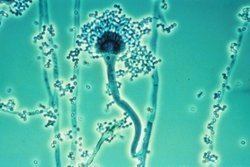ICD-10 J30.89 | ||
 | ||
eMedicine Sinusitis/topic863062.htm Fungal Sinusitis/863062 | ||
Fungal sinusitis is the inflammation of the lining mucosa of the paranasal sinuses due to fungal infection. It occurs in people with reduced immunity. The maxillary sinus is the most commonly involved. Fungus responsible are Aspergillus fumigatus (90%), Aspergillus flavus and Aspergillus niger. Fungal sinusitis occurs most commonly in middle-aged populations. Diabetes mellitus is the most common risk factor involved.
Contents
Types
The types of fungal sinusitis are based on invasive and non-invasive as follows:
Signs/symptoms
Individuals with the condition of fungal sinusitis mostly present with features that include facial pain and pain around the eyes, nasal congestion, rhinorrhea(running nose), headache, later there may be ophthalmoplegia(paralysis of ocular muscles)
Pathophysiology
The mechanism of fungal sinusitis depends on which form, such as:
Diagnosis
In terms of diagnosis, the clinical examination gives an idea about fungal sinusitis, as well as:
Treatment
Treatment for fungal sinusitis can include surgical debridement helps by slowing progression of disease thus allowing time for recovery additionally we see the options below:
Epidemiology
Though it is widely held that fungal infections of the nose and paranasal sinuses are not common, most agree that their frequency has been increasing over past decades.
